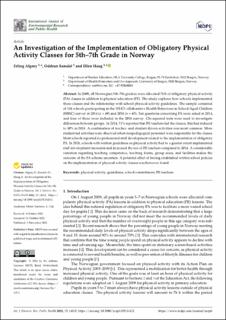| dc.contributor.author | Algrøy, Erling Andre | |
| dc.contributor.author | Samdal, Oddrun | |
| dc.contributor.author | Haug, Ellen Merethe Melingen | |
| dc.date.accessioned | 2022-12-23T08:27:36Z | |
| dc.date.available | 2022-12-23T08:27:36Z | |
| dc.date.created | 2022-12-05T06:33:44Z | |
| dc.date.issued | 2022 | |
| dc.identifier.issn | 1661-7827 | |
| dc.identifier.uri | https://hdl.handle.net/11250/3039313 | |
| dc.description.abstract | In 2009, all Norwegian 5th–7th graders were allocated 76 h of obligatory physical activity (PA) classes in addition to physical education (PE). The study explores how schools implemented these classes and the relationship with school physical activity guidelines. The sample consisted of 134 schools participating in the WHO collaborative Health Behaviour in School-Aged Children (HBSC) survey in 2014 (n = 69) and 2018 (n = 65). Ten questions concerning PA were asked in 2014, and four of these were included in the 2018 survey. Chi-squared tests were used to investigate differences between groups. In 2014, 51% reported that PE teachers led the classes; this had reduced to 30% in 2018. A combination of teacher- and student-driven activities was most common. More student-led activities were observed when nonpedagogical personnel were responsible for the classes. Most schools reported no professional staff development related to the implementation of obligatory PA. In 2018, schools with written guidelines on physical activity had to a greater extent implemented staff development measures and increased the use of PE teachers compared to 2014. A considerable variation regarding teaching competence, teaching forms, group sizes, and facilities makes the outcome of the PA scheme uncertain. A potential effect of having established written school policies on the implementation of physical activity classes was however found. | en_US |
| dc.language.iso | eng | en_US |
| dc.publisher | MDPI | en_US |
| dc.rights | Navngivelse 4.0 Internasjonal | * |
| dc.rights.uri | http://creativecommons.org/licenses/by/4.0/deed.no | * |
| dc.title | An investigation of the implementation of obligatory physical activity classes for 5th-7th grade in Norway | en_US |
| dc.type | Journal article | en_US |
| dc.type | Peer reviewed | en_US |
| dc.description.version | publishedVersion | en_US |
| dc.rights.holder | Copyright 2022 The Author(s) | en_US |
| dc.source.articlenumber | 14312 | en_US |
| cristin.ispublished | true | |
| cristin.fulltext | original | |
| cristin.qualitycode | 1 | |
| dc.identifier.doi | 10.3390/ijerph192114312 | |
| dc.identifier.cristin | 2088359 | |
| dc.source.journal | International Journal of Environmental Research and Public Health (IJERPH) | en_US |
| dc.identifier.citation | International Journal of Environmental Research and Public Health (IJERPH). 2022, 19 (21), 14312. | en_US |
| dc.source.volume | 19 | en_US |
| dc.source.issue | 21 | en_US |

